Using the governance repository to dynamically update EBX® tips and labels
Updating tips and labels overview
Definitions applied to tables and fields can be reused to dynamically configure tool-tips and labels. Rather than using values specified in the data model, definitions can be enriched from the EBX® Information Governance Add-on repository.
You can associate a user profile with a context so that those users will see information specific to their needs. For instance, a table in the data model with a default label of 'Empl', will automatically display as 'Employee' or 'Staff' depending on the context with which a user's profile is associated.
As highlighted in the next section, the add-on's API needs to be declared in order to use the governance repository to dynamically update tips and labels.
Declaring the add-on's API in a data model
Once a data model has been extended with the following declaration, tool-tips and labels applied to the tables and fields are retrieved from the governance repository. To configure how this information displays, see the next section 'Configuring tooltips and labels'.
Step 1: Add the default API class "com.orchestranetworks.addon.igov.IGovLabelingSchemaDocumentation" to the data model's Component library.
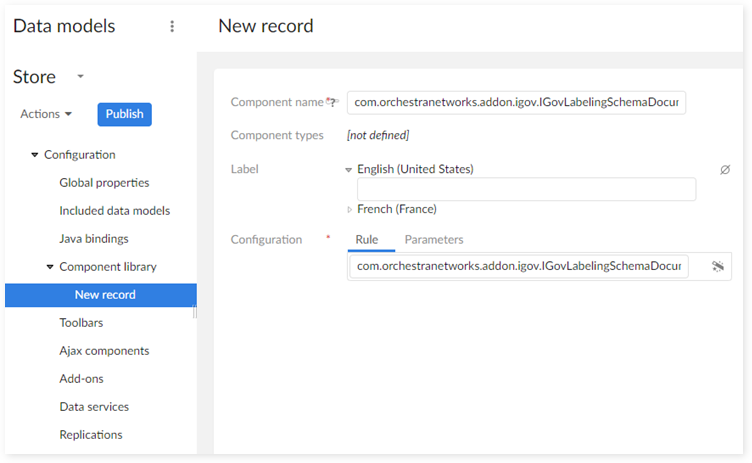
Step 2: Navigate to the 'Data model properties' and in the 'Documentation' field select the API class you just added.
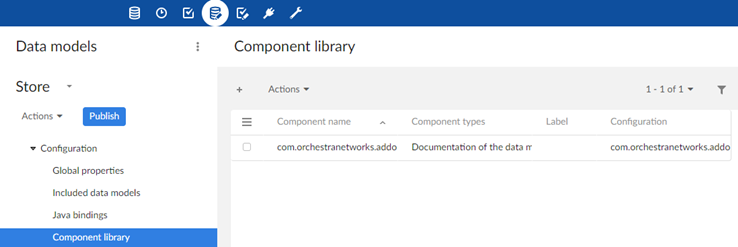
Configuring info-tips and labels
If you have administrative access, you can configure the add-on's info-tips and labels by opening the 'Administrative' tab > 'Metadata Management' > 'TIBCO EBX® Information Governance Add-on > 'Infotip and labels'.
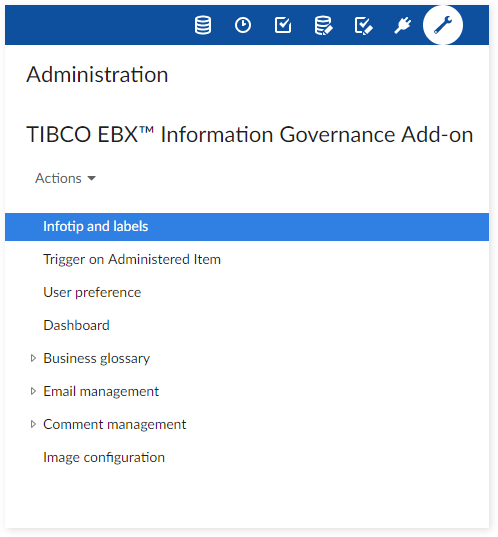
The table below describes the properties that you can configure. Please refer to the Java doc for a technical description of the API.
Property | Definition |
|---|---|
User profile | The user profile to which this add-on API configuration applies. |
IGov repository | The data space for the add-on repository to use. |
Data model | The data model to which the API configuration applies. |
Info-tip is active | If 'True': The add-on repository provides the info-tip. If 'False': The data model provides the information for the info-tip. |
Table label is active | If 'True': The add-on repository provides the table label. If 'False': The data model provides the information for the table label. |
Field label is active | If 'True': The add-on repository provides the field label. If 'False': The data model provides the field label. |
Main context | The main context that determines the definition provided by the add-on repository. |
Alternative context | The alternative context that determines the definition provided by the add-on repository when the main context can not be fulfilled. |
DMA context by default | If the main context and alternative context are not implemented, then the DMA context can be used to define the tool-tip:
|
Add D.E.C. in the field definition | If 'True': The field's info-tip displays the definition of its associated Data Element Concept (D.E.C.). If 'False': The field's info-tip is not enriched with the definition of its associated D.E.C. For instance, the 'age' field is a Property in the add-on repository with its own definition. But, the 'age' field in the 'Employee' table is also a D.E.C. with own definition. |
Use D.E.C. as field label | If 'True': The field's label comes from the related Data Element Concept (D.E.C) in the add-on repository. If 'False': The field's label comes from the related Property in the add-on repository. For instance, the 'age' field is defined as the 'Age' property in the add-on repository and also included in the 'Employee' table as a D.E.C. Depending on whether the 'Use D.E.C as field label' is True or False, the label will come from either the property or the associated D.E.C. |
Hide Universal name | Determines whether the 'Universal name' displays when users view the tool tip. |
Rule activation group | |
Display rule information | Determines whether rule information, such as rule name and description, display in the tool tip. Note that linked rules are declared in an Item's 'Rule' tab. |
Maximum number of rules | Specifies the number of rules displayed on the tool tip. |
Examples
The next sections illustrate the following uses cases:
Info-tip not activated.
Info-tip activated.
Label on table activated.
Dynamically naming tables using contexts.
Dynamic naming fields using contexts.
Customizing EBX® Information Governance Add-on naming
Info-tip not activated
As illustrated, the 'Info-tip is active' property is set to 'No'. The 'Table 1' name and definition display the values from the data model for 'Table 1'. Any additional information from the governance repository does not display.

Info-tip activated
As illustrated below when the 'Info-tip is active' property is set to 'Yes', a tool-tip displays the 'Universal name' and information from the governance repository.
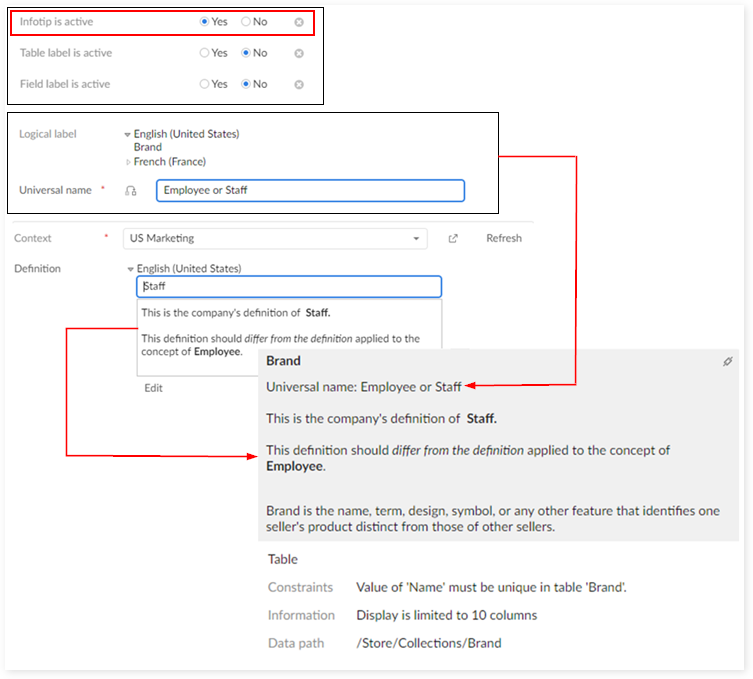
Label on table activated
When the 'Table label is active' property is set to 'Yes', the table name that displays is automatically provided by the governance repository. In the illustration below the 'US Marketing' context is used and the table label displays as 'Staff' instead of 'Table 1'.
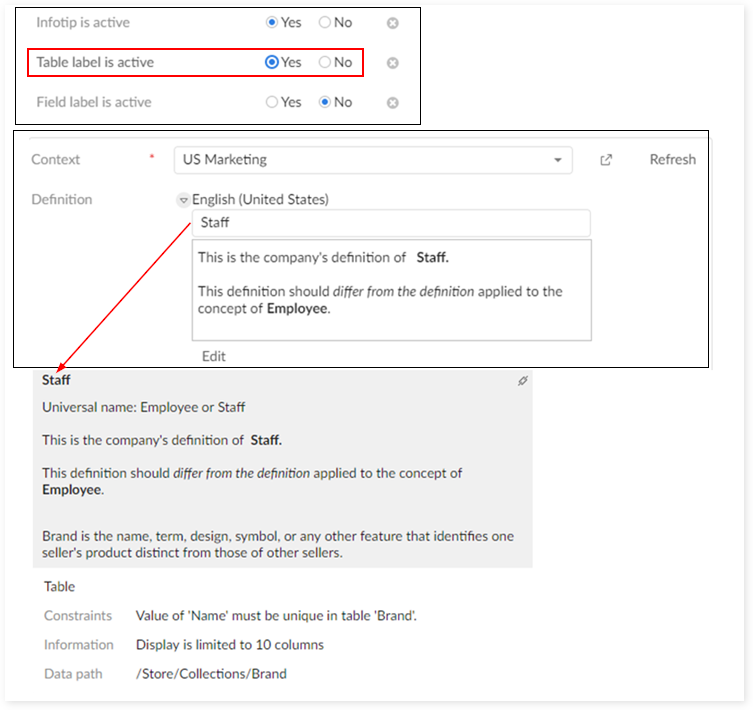
Dynamically naming tables by using contexts
All tool-tip and label definitions in the governance repository are associated with contexts. As shown below, you can assign a main and alternative context to a user profile.
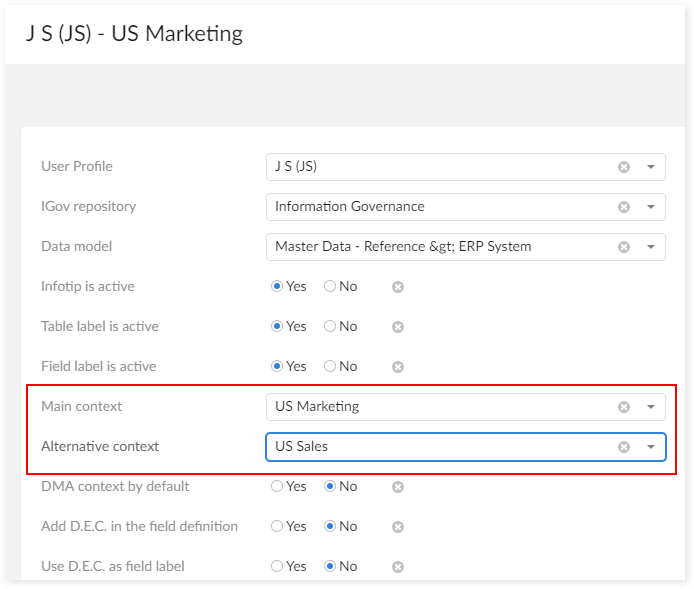
After assigning contexts to a user profile, information relevant to their work environment can dynamically display. The following image illustrates how information displays depending on the context associated with the user profile.
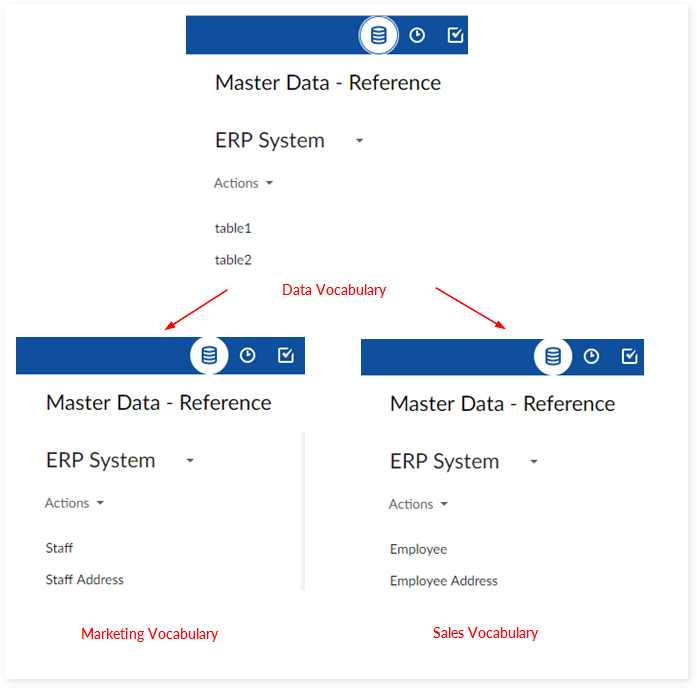
Dynamically naming fields by using contexts
Just as with table names and tool-tips, the information displayed in table fields can be dynamically updated based on a user profile's associated context. Data can be better understood by users when it is presented in a way familiar to them.
The illustration below shows how the field labels are customized depending on whether a 'Manufacturing' or 'Sales' context is used.
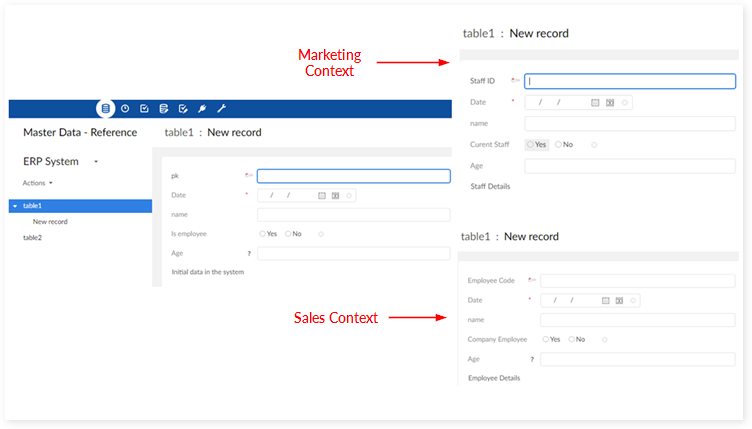
Customizing EBX® Information Governance Add-on naming
You can change the add-on naming in the same way as with your own data models. These add-on applies these changes by context and user profile which allows you to tailor what specific users, or groups of users see. The image below shows an example of changing the 'Item' table to 'Governed Elements'.
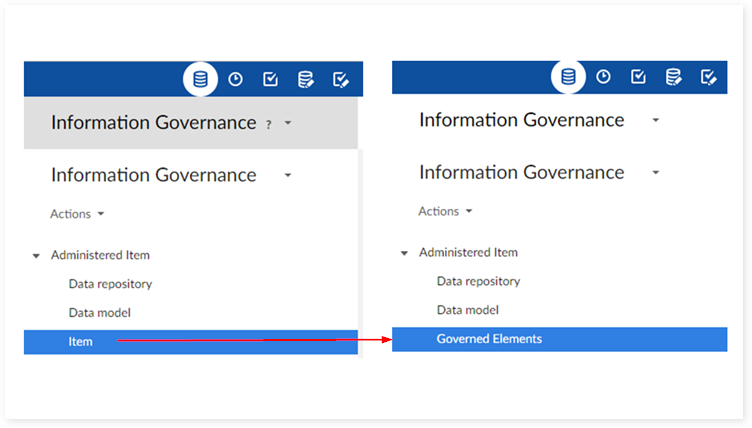
To configure info-tips and labels for the Information Governance data model:
Create a new record in the 'Data model' table.
Specify the ebx-addon-igov.xsd in the 'Data model' property.
Use the next two drop-down lists to select the desired data space and data set.
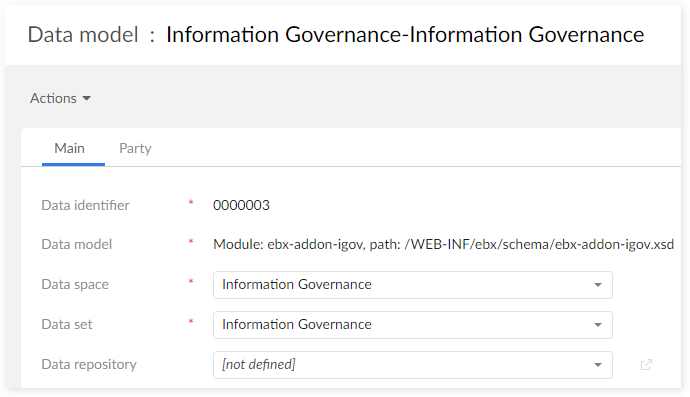
After updating any other desired properties, save and close.
In the 'Data model' table, select the check box corresponding to the data model you just created and from the 'Actions' menu select 'Information Governance' > 'Create Administered Items'.
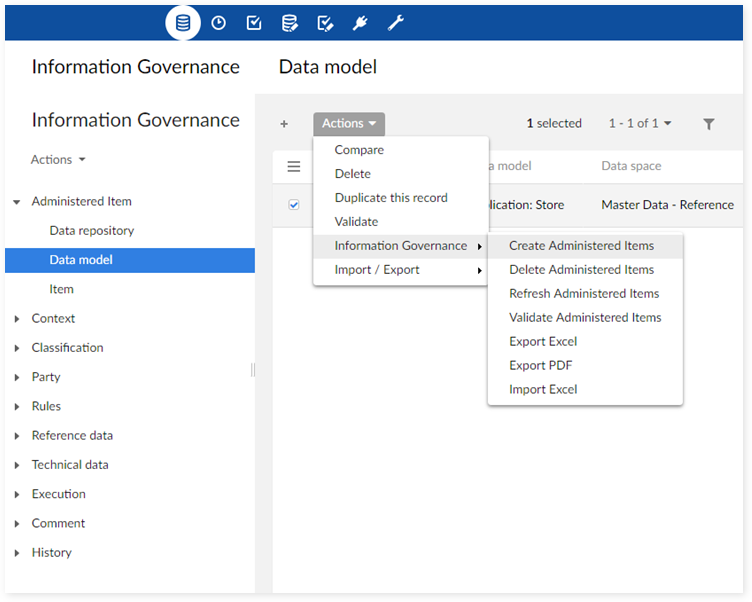
In the 'Item' table navigate to and select the table, or field you want to update. In this example we are updating the 'Item' table itself.
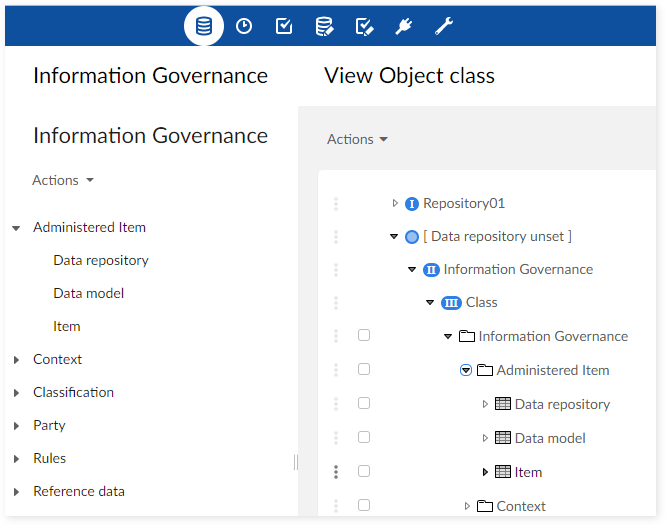
Open the table's 'Definition' tab and create a new context and definition. The add-on displays the text you specify in the 'Definition' field when a user and data model are associated with the context. In this example, we entered 'Governed Elements'.
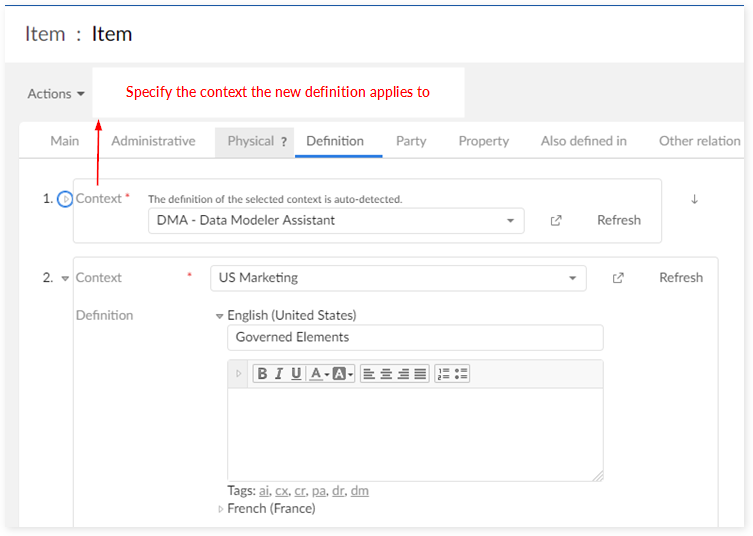
Create a new 'Infotip and labels' configuration that associates the user, context and data model.
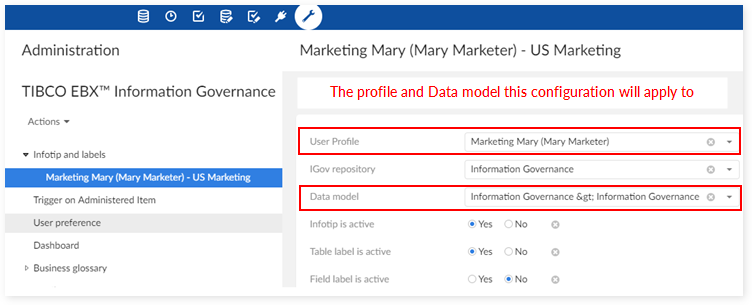
Display rules for tips and labels
The display of info-tips and labels conforms to the following guidelines for users and roles. If a configuration is specified for a user, this configuration is used even if there are other configurations for the role(s) that this user belongs to. If no configuration exists for a user, the add-on uses the first role returned that this user is configured for. For example, if sorted by creation date (oldest to newest), the first record for this role will be an older record.
Rules applied to info-tip
EBX® element | ISO concept | Display Rules |
|---|---|---|
Table | Object class | Universal name Definition of the Object class for the configured context Default definition of the table from the Data model |
Field | Property | Universal name Definition for the Property for the configured context Default definition of the field from the Data model If 'Add D.E.C. in the field definition' = 'Yes' then:
|
Group of field | Object class | Universal name Definition of the Object class for the configured context Default definition of the table from the Data model |
Rules applied to label
EBX® element | ISO concept | Display Rules |
|---|---|---|
Table | Object class | Short definition of the Object class for the configured context |
Field | Property | If 'Use D.E.C. as field label' = 'Yes'
If 'Use D.E.C. as field label' = 'No'
|
Group of field | Object class | Short definition of the Object class for the configured context |